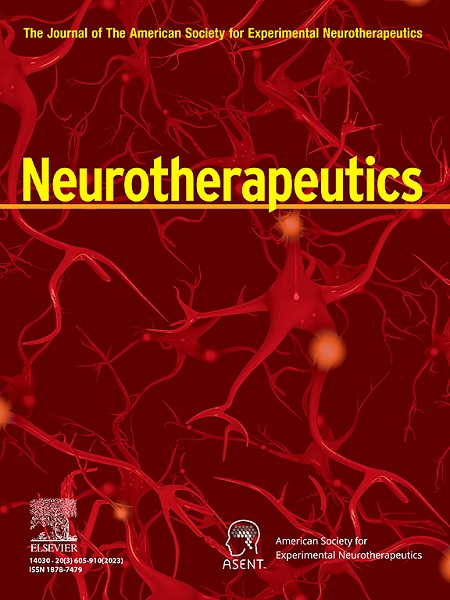IGF-1 impacts neocortical interneuron connectivity in epileptic spasm generation and resolution
IF 5.6
2区 医学
Q1 CLINICAL NEUROLOGY
引用次数: 0
Abstract
Little is known about the mechanisms that generate epileptic spasms following perinatal brain injury. Recent studies have implicated reduced levels of Insulin-like Growth Factor 1 (IGF-1) in these patients’ brains. Other studies have reported low levels of the inhibitory neurotransmitter, GABA. In the TTX brain injury model of epileptic spasms, we undertook experiments to evaluate the impact of IGF-1 deficiencies on neocortical interneurons and their role in spasms. Quantitative immunohistochemical analyses revealed that neocortical interneurons that express glutamic acid decarboxylase, parvalbumin, or synaptotagmin 2 co-express IGF-1. In epileptic rats, expression of these three interneuron markers were reduced in the neocortex. IGF-1 expression was also reduced, but surprisingly this loss was confined to interneurons. Interneuron connectivity was reduced in tandem with IGF-1 deficiencies. Similar changes were observed in surgically resected neocortex from infantile epileptic spasms syndrome (IESS) patients. To evaluate the impact of IGF-1 deficiencies on interneuron development, IGF-1R levels were reduced in the neocortex of neonatal conditional IGF-1R knock out mice by viral injections. Four weeks later, this experimental maneuver resulted in similar reductions in interneuron connectivity. Treatment with the IGF-1 derived tripeptide, (1–3)IGF-1, abolished epileptic spasms in most animals, rescued interneuron connectivity, and restored neocortical levels of IGF-1. Our results implicate interneuron IGF-1 deficiencies, possibly impaired autocrine IGF-1 signaling and a resultant interneuron dysmaturation in epileptic spasm generation. By restoring IGF-1 levels, (1–3)IGF-1 likely suppresses spasms by rescuing interneuron connectivity. Results point to (1–3)IGF-1 and its analogues as potential novel disease-modifying therapies for this neurodevelopmental disorder.

IGF-1 在癫痫痉挛的产生和缓解过程中影响新皮层中间神经元的连接。
人们对围产期脑损伤后产生癫痫痉挛的机制知之甚少。最近的研究表明,这些患者大脑中的胰岛素样生长因子 1(IGF-1)水平降低。其他研究报告称,抑制性神经递质 GABA 的水平较低。在 TTX 脑损伤癫痫痉挛模型中,我们进行了实验,以评估 IGF-1 缺乏对新皮质中间神经元的影响及其在痉挛中的作用。定量免疫组化分析表明,表达谷氨酸脱羧酶、parvalbumin 或 synaptotagmin 2 的新皮层中间神经元共同表达 IGF-1。在癫痫大鼠的新皮层中,这三种中间神经元标记物的表达量减少。IGF-1 的表达也减少了,但令人惊讶的是,这种损失仅限于中间神经元。在 IGF-1 缺乏的同时,神经元间的连接也减少了。在婴儿癫痫痉挛综合征(IESS)患者手术切除的新皮层中也观察到了类似的变化。为了评估 IGF-1 缺乏对中间神经元发育的影响,通过病毒注射降低了新生条件性 IGF-1R 基因敲除小鼠新皮层中的 IGF-1R 水平。四周后,这种实验操作导致神经元间的连接性出现类似的降低。用IGF-1衍生的三肽--(1-3)IGF-1治疗可消除大多数动物的癫痫痉挛,恢复神经元间的连接性,并恢复新皮层的IGF-1水平。我们的研究结果表明,神经元间 IGF-1 缺乏、自分泌 IGF-1 信号可能受损以及由此导致的神经元间发育不良与癫痫痉挛的产生有关。通过恢复 IGF-1 水平,(1-3)IGF-1 可能会通过修复神经元间的连接来抑制痉挛。研究结果表明,(1-3)IGF-1 及其类似物是治疗这种神经发育障碍的潜在新型疾病调节疗法。
本文章由计算机程序翻译,如有差异,请以英文原文为准。
求助全文
约1分钟内获得全文
求助全文
来源期刊

Neurotherapeutics
医学-神经科学
CiteScore
11.00
自引率
3.50%
发文量
154
审稿时长
6-12 weeks
期刊介绍:
Neurotherapeutics® is the journal of the American Society for Experimental Neurotherapeutics (ASENT). Each issue provides critical reviews of an important topic relating to the treatment of neurological disorders written by international authorities.
The Journal also publishes original research articles in translational neuroscience including descriptions of cutting edge therapies that cross disciplinary lines and represent important contributions to neurotherapeutics for medical practitioners and other researchers in the field.
Neurotherapeutics ® delivers a multidisciplinary perspective on the frontiers of translational neuroscience, provides perspectives on current research and practice, and covers social and ethical as well as scientific issues.
 求助内容:
求助内容: 应助结果提醒方式:
应助结果提醒方式:


